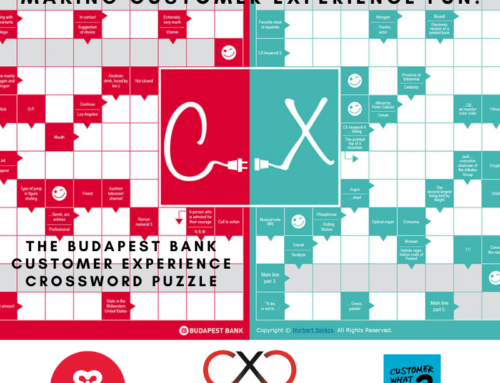Have you ever wondered whether there is really any hope for your organisation? Have you ever turned up one day wondering if you are the only person in the building who really gets it? Are you the only person who understands that the organisation needs to do something different to genuinely put its customers first? Have you had days when you can see some light at the end of the tunnel, only for it to be extinguished before you get anywhere near it?
If you have answered ‘yes’ to any of those questions, I can confidently confirm that you are very much NOT alone. In my time as a customer experience professional, I have often wondered if I am completely mad (some of my colleagues would probably say ‘yes’ to this). I have always thought that in my motivation to do the right things for customers, surely everyone else would agree with me. I have never been swayed by politics or selfish ambition – only to do what is right – but too often I have continually hit against brick wall after brick wall.
As a customer experience professional, you become practised at understanding where your key stakeholders sit in terms of their support for your efforts. You know who the advocates are, and are even more clear as to who the detractors are. You learn to never give up and to continue to strive to do the right thing. What you also learn is that every organisation is completely different, and this means that their ability to change is different. Essentially, not every organisation is ready to become customer focussed – even if they think they are.
The more ‘ready’ your organisation is (or the people are within it), the easier it will be to embed an all-encompassing customer experience improvement initiative that can and will be sustained. The less ‘ready’, the more difficult it will be. My experiences have led me to see that there are actually four different phases of readiness. That is why I have created the ‘customer readiness scale’ – a way of self assessing how ready your organisation is to embark on its customer experience initiative. The customer readiness scale allows you to determine where either the whole organisation, or key stakeholders within it, sit in terms of readiness.
So let’s have a look at the different phases of readiness:
1. ACKNOWLEDGE – acknowledgement that the existing state of customer experience is unacceptable and requires improvement
There are too many organisations who are not prepared to admit there is a problem. These organisations sit in this phase of readiness. There are many reasons that could be driving this behaviour. It does not mean it is impossible to introduce a customer experience initiative/programme, but it makes it VERY difficult. You may need to operate very tactically, doing whatever it takes to PROVE that there is a problem, to get ‘heads out of the sand’ so to speak! Many of the retail businesses that have hit financial difficulties in the UK recently may have had individuals who were at this phase of readiness.
2. DIAGNOSE – agreement to both identify and accept what and where problems exist in the customer experience
Once there is acknowledgement, you are then able to determine exactly what is causing the problem. This phase of readiness combines both the identification of the problem AND the acceptance of it – i.e. your leaders saying something along the lines of ‘yes I agree that this is the cause of the problem and something needs to be done about it’! Do not underestimate how common it is for people to become defensive at this stage – readiness here will require honesty and openness to the causes of the problem.
3. ACTION – agreement to implement a series of appropriate actions to address the problems identified in the diagnosis phase
When your organisation is ready to do something about the causes of customer dissatisfaction – you are doing pretty well. That means that there has been acknowledgement of the problem, and identification of the things that need to be addressed. HOWEVER – this is the phase of readiness where the ‘proof is in the pudding’. I have had many situations where I have successfully got past phase 2 – only for the decision makers to ‘change their minds’ when I have proposed the actions that should/must be taken. Phase 3 is the real test of readiness – it is only when your organisation is really ready to take action that you know your customer experience efforts are on the right track.
4. IMPROVE – implementation of a programme of improvement to enable the organisation to continuously meet the changing needs of customers
Starting to take action is great, but it is the sustainability of the action and subsequent improvements that are key to a long-lasting focus on customer experience. The 4th phase of readiness is IMPROVE – the phase that sees your organisation embedding a continuous customer experience improvement programme in its very fabric. This is the enigma – the phase to get to that ensures that meeting and exceeding customer needs is just a way of life. It means that the mechanisms are in place to ensure that whatever needs to be done to improve the customer experience will be forever.
So how do you determine where your organisation sits? To help you make your decision, I have created the readiness scale – a detailed chart to plot your business and key stakeholders on. The scale is used like a map, thus 1D is the least desirable state of readiness, and 4A is the most desirable.
Plotting your organisation or key stakeholders within it, on this scale is an iterative process. You can move up and down, left and right, depending on what is happening. The objective is to aim to get to 4A. I am not able to tell you where the organisations I have worked with and for sit on the scale – although I would love to!! Buy me a beer the next time you see me and I might!!
Improving the customer experience is not easy – just ask any committed customer experience professional. Understanding how ready (or not) your business is to accept the change needed to become more customer focussed WILL help you plan your customer experience programme more effectively. There is no point creating a detailed customer experience strategy if the board of directors do not think they actually have a problem in the first place! Now you know the state of readiness of your organisation, you can start or continue to plan to address the issues.
Will the customer experience readiness scale stop you from having to bang your head against a brick wall? Regrettably it will not. It will help you to have clarity as to why you might be hitting the wall in the first place though!!
What do you think about the readiness scale? I would love to hear your views.










[…] recognise that every organisation is different. Every organisation will have a different state of ‘readiness’ when it comes to adopting a customer centric culture. If you push too hard too soon, you may fail […]
[…] recognise that every organisation is different. Every organisation will have a different state of ‘readiness’ when it comes to adopting a customer centric culture. If you push too hard too soon, you may fail […]